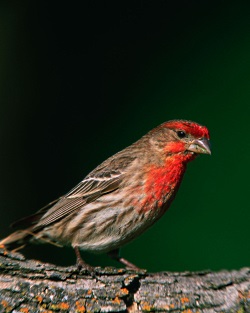
Courtesy US FWS, Gary Kramer, Photographer
A man’s vanity is nowhere more apparent than for the hair atop his head. As men age, their hair may whiten, thin or disappear. As a remedy, some men use dyes or hair growth potions.
But imagine this: What if the right food alone could restore the virile dark hair of youth?
There is a common songbird at your birdfeeder this winter that can do just this. It is the male house finch.
[House Finch Call – #3 Songbirds of the Southwest Canyon Country]
As with many songbirds, the female house finch is drab compared to the brightly colored male. He sports a showy brow and bib in colors that range from tomato red to orange to straw yellow. Like the tomato and carrot, these colors come from pigments called carotenoids. All birds with red feathers get these carotenoid pigments from their diet, ultimately from the plants that can produce them.
What does the red feather color mean for the house finch?
The ornathologist Geof Hill of Auburn University experimentally altered head feather colors of male house finches. To make red-headed males into carrot tops, Jeff used peroxide. Red hair die achieved the opposite transformation. He then let the guys compete for the attentions of females.
Jeff’s experiments demonstrated that plumage does make the male. The redder the male’s head, the higher his place in the pecking order. And the more females that he could attract. Conversely, redheads lost rank after bleaching. Among male house finches, blondes really don’t have more fun.
So now you can predict the likely winners and losers in the mating game from just a glance at the male house finches at your seed feeder. As is common in science, this discovery leads to new questions: What food makes the male’s head feathers red? Is it some red fruit or berry? Why do some males manage to get more carotenoid pigments than others? Do they instinctively know the right seed or fruit to eat? We humans must get our carotenoids from plant sources too, such as the carotine that we transform into Vitamin A for night vision. The produce aisle at the grocery store might be a much different place though if the right fruit or vegetable could transform our hair color too.
This is Linda Kervin for Bridgerland Audubon Society.
Credits:
Photo: Courtesy US FWS, Gary Kramer, Photographer
Bird Sounds: Courtesy and Copyright 2008 Dr. Kevin Colver, Songbirds of the Southwest Canyon Country https://wildstore.wildsanctuary.com/collections/special-collections
Text: Jim Cane and Linda Kervin, Bridgerland Audubon Society https://www.bridgerlandaudubon.org
Voice: Linda Kervin
Additional Reading:
House Finch, Carpodacus mexicanus, Utah Division of Wildlife Resources, Department of Natural Resources, State of Utah, https://fieldguide.wildlife.utah.gov/?species=haemorhous%20mexicanus
House Finch, Utah Bird Profile, UtahBirds.org, https://www.utahbirds.org/birdsofutah/ProfilesD-K/HouseFinch.htm
A Red Bird in a Brown Bag: The Function and Evolution of Colorful Plumage in the House Finch , Dr. Geoffrey, E. Hill, Oxford University Press, September 2002
ISBN-13: 9780195148480, https://www.amazon.com/Red-Bird-Brown-Bag-Ornithology/dp/0195148487
New Addition: How birds turn red, Phys.org, May 19, 2016, http://phys.org/news/2016-05-genes-enable-birds-red.html
Pharr, Lauren D., Seeing Red: What the Color of House Finches Can Tell Us, Cool Green Science, The Nature Conservancy, November 2, 2021, https://blog.nature.org/2021/11/02/seeing-red-what-the-color-of-house-finches-can-tell-us/
Lowe, Joe, Invasive Birds of the U.S.: Seven of the Most Common Species, Bird Calls Blog, American Bird Conservancy, February 24, 2020, https://abcbirds.org/blog20/invasive-birds/
Leffer, Lauren, 10 Fun Facts about the House Finch, News, National Audubon Society, December 21, 2021, https://www.audubon.org/news/10-fun-facts-about-house-finch
